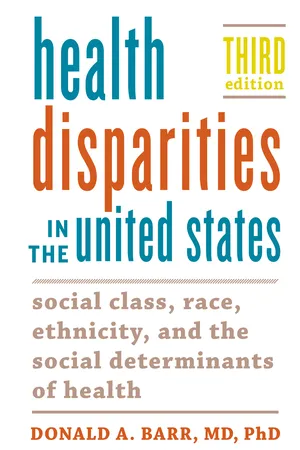
Health Disparities in the United States
Social Class, Race, Ethnicity, and the Social Determinants of Health
- English
- ePUB (mobile friendly)
- Available on iOS & Android
Health Disparities in the United States
Social Class, Race, Ethnicity, and the Social Determinants of Health
About this book
Challenging students to think critically about the complex web of social forces that leads to health disparities in the United States.
The health care system in the United States has been called the best in the world. Yet wide disparities persist between social groups, and many Americans suffer from poorer health than people in other developed countries. In this revised edition of Health Disparities in the United States, Donald A. Barr provides extensive new data about the ways low socioeconomic status, race, and ethnicity interact to create and perpetuate these health disparities. Examining the significance of this gulf for the medical community and society at large, Barr offers potential policy- and physician-based solutions for reducing health inequity in the long term.
This thoroughly updated edition focuses on a new challenge the United States last experienced more than half a century ago: successive years of declining life expectancy. Barr addresses the causes of this decline, including what are commonly referred to as "deaths of despair"—from opiate overdose or suicide. Exploring the growing role geography plays in health disparities, Barr asks why people living in rural areas suffer the greatest increases in these deaths. He also analyzes recent changes under the Affordable Care Act and considers the literature on how race and ethnicity affect the way health care providers evaluate and treat patients.
As both a physician and a sociologist, Barr is uniquely positioned to offer rigorous medical explanations alongside sociological analysis. An essential text for courses in public health, health policy, and sociology, this compelling book is a vital teaching tool and a comprehensive reference for social science and medical professionals.
Frequently asked questions
- Essential is ideal for learners and professionals who enjoy exploring a wide range of subjects. Access the Essential Library with 800,000+ trusted titles and best-sellers across business, personal growth, and the humanities. Includes unlimited reading time and Standard Read Aloud voice.
- Complete: Perfect for advanced learners and researchers needing full, unrestricted access. Unlock 1.4M+ books across hundreds of subjects, including academic and specialized titles. The Complete Plan also includes advanced features like Premium Read Aloud and Research Assistant.
Please note we cannot support devices running on iOS 13 and Android 7 or earlier. Learn more about using the app.
Information
Table of contents
- Cover Page
- Also by the Author
- Title Page
- Copyright Page
- Dedication
- Contents
- Preface
- 1. Introduction to the Social Roots of Health Disparities
- 2. What Is “Health”? How Should We Define It? How Should We Measure It?
- 3. The Relationship between Socioeconomic Status and Health, or, “They Call It ‘Poor Health’ for a Reason”
- 4. Understanding How Low Social Status Leads to Poor Health
- 5. Race, Ethnicity, and Health
- 6. Race/Ethnicity, Socioeconomic Status, and Health: Which Is More Important in Affecting Health Status?
- 7. Children’s Health Disparities
- 8. All Things Being Equal, Does Race/Ethnicity Affect How Physicians Treat Patients?
- 9. Why Does Race/Ethnicity Affect the Way Physicians Treat Patients?
- 10. When, if Ever, Is It Appropriate to Use a Patient’s Race/Ethnicity to Help Guide Medical Decisions?
- 11. What Should We Do to Reduce Health Disparities?
- References
- Index